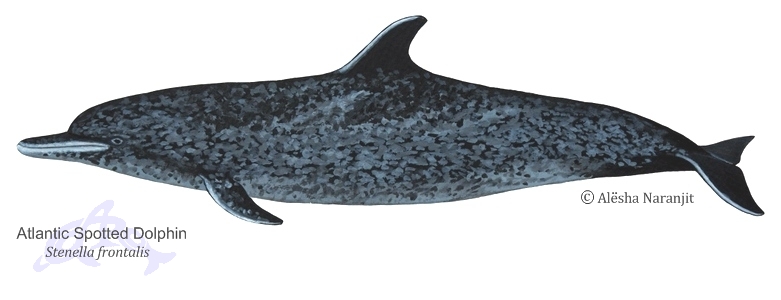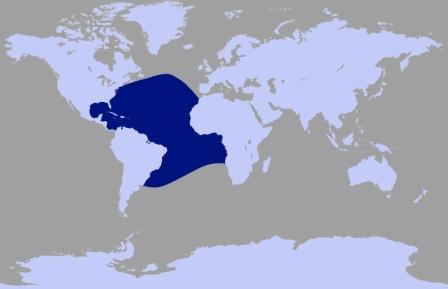Atlantic Spotted Dolphin
Stenella frontalis
Stenella frontalis

Classification Scientific Name: Stenella frontalis Other Names: Spotted Porpoise, Spotter, Brindled Dolphin, Gulf Stream Spotted Dolphin, Long-snouted Dolphin. Suborder: Odontoceti Family: Delphinidae | Description The Atlantic Spotted Dolphin has a fairly robust head and body with a moderately long, chunky beak and white lips. There is age-related variation in spotting but individuals usually have a three-toned colour pattern: a dark grey cape with a band of medium grey along the sides and a white underside showing through the spotting. Adults are heavily spotted sometimes obscuring the three-toned pattern and the usual eye-flipper or gape-flipper stripe. The dorsal fin is tall and generally falcate and the flippers broad based, with a well defined curve and pointed tips. These dolphins can be very active at the surface and highly acrobatic. They are attracted to fast moving vessels and often bow-ride, they also commonly associate with bottlenose dolphins.
|
Atlantic Spotted Dolphin Ecology Range: Tropical and warm temperate waters of the Atlantic Ocean. Usual Habitat: Uses both inshore and offshore waters. Usual group size: 5-15, sometimes up to 200 but usually less than 50 Main Diet: Fish, cephalopods and deep water invertebrates. Local population: Unknown | Global range of the Atlantic Spotted Dolphin  Atlantic Spotted Dolphins are likely to be found in the dark blue areas |
Conservation Information
IUCN Conservation Status: Atlantic Spotted Dolphins are listed as "Data Deficient" on the IUCN red list.
SPAW Protocol: Atlantic Spotted Dolphins are cetaceans, which are listed under Annex II of the SPAW protocol. As such they require total protection under article 11 of this protocol which prohibits the "taking, possession, killing and commercial trade of the species, their parts or products". The SPAW protocol was created to help with the implementation and promotion of the Ramsar Convention and the Convention on Biological Diversity. The Annexes of the SPAW protocol can be found here. Local Laws: Cetaceans are protected under the Conservation of Wildlife Act of Trinidad and Tobago which offers protection to all species not listed under the second or third schedules of this act. |
Reports of Atlantic Spotted Dolphins in Trinidad and Tobago
This is currently being researched and written. It will appear here shortly.
This is currently being researched and written. It will appear here shortly.
References
The above information was obtained from the following sources:
- A Princeton Field Guide: Whales Dolphins and Other Marine Mammals of the World by Hadoram Shirihai and Brett Jarrett (2006)
- Smithsonian Handbooks: Whales Dolphins and Porpoises by Mark Carwardine and illustrated by Martin Camm (2002)
- The Whale and Dolphin Conservation Society's Species Guide at http://www2.wdcs.org/species/index.php
- The IUCN Redlist at http://www.iucnredlist.org
- The SPAW protocol Annexes with links available at http://www.car-spaw-rac.org/?Annexes-of-the-SPAW-Protocol,83
We would like to thank the following people for the use of the art work and photographs:
- Alësha Naranjit (Illustration of Atlantic Spotted Dolphin)